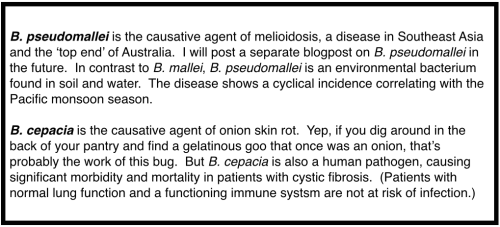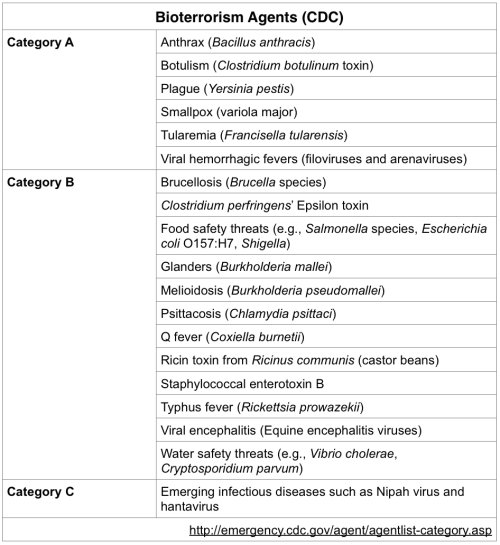Glanders is in the news. Recently, the Texas Animal Health Commission confirmed the disease in a Mexican donkey which strayed across the southern US border.
Glanders is a nearly forgotten bacterial disease of equids (horses, donkeys, mules) that can also cause infections of other animals as well as humans. Identification of glanders in a donkey in the US is significant because this is the first naturally occurring case of equine glanders in the US since 1942.
Glanders is a disease of antiquity described by Hippocrates and the Romans. It is caused by a Gram negative rod, Burkholderia mallei, and is an obligate pathogen of mammals (ie, there is no environmental reservoir). I am always amazed to think of a disease that has survived millennia hopping from host to host in an unbroken chain. To think the bacteria infecting this Mexican donkey may be descended from bacteria that felled horses in the time of the Caesars – incredible!
The genus Burkholderia includes 3 significant pathogens: B. mallei, B. pseudomallei, and B. cepacia. (See separate text box.)
Because of the organism’s proclivity towards infection of draft animals, B. mallei became a potential weapon of war. At a time when horses were crucial to military campaigns, both for cartage and cavalry, an outbreak of glanders among horses could devastate military readiness and alter the course of battle. Glanders was widespread among the horses of both sides during the American Civil War (Sharrer, 1995).

US Army Veterinary Hospital No. 11, Gievres, France, WW 1.
Testing horse for glanders.
Source: National Library of Medicine.
Common Domain.
The disease was suspected to have been used as a biological agent in both World Wars One and Two. The United States actively researched glanders as a biological warfare agent beginning in the 1940s. (Sidell, FR, ET Takafuji, and DR Franz, eds. 1997). Despite accusations, and some evidence of use, the ultimate outcomes of the these wars were not affected by attempts at biological warfare.
Though the disease was eradicated from the United States in 1942, infections have occurred among laboratory workers since then. An illustrative (and relatively recent) case occurred in May, 2000, when a microbiologist working at the U.S. Army Medical Research Institute of Infectious Diseases (USAMRIID) initially presented with a left axillary mass and fevers. He was treated with an intra-muscular injection of ceftriaxone and a 10 day course of cephalexin, but he continued to be ill with fevers, fatigue, night sweats, malaise, and weight loss. He was prescribed a 10 day day course of clarithromycin, but his symptoms continued and he developed abdominal pain. A subsequent CT scan documented multiple hepatic and splenic abscesses and culture of a liver aspirate yielded B. mallei. (Anon. MMWR 49(24): 532- 5.)
Despite eradication of the disease in the United States, the disease continues to be enzootic in Central and South America, Asia, Africa, and the Middle East. Thus there is the risk in the US of imported animal and human cases. Infectious diseases thought to have been successfully eradicated may re-emerge from areas of endemnicity. In this case, a wayward infected donkey crossed from Mexico into Texas.
Diseases of low incidence (and even thought eradicated) should not be forgotten despite the low likelihood any particular clinician will see one of these diseases in clinic. Yes, if you hear hoofbeats, think of horses – but that does not mean you should forget that zebras are out there. As an example, in my clinical practice I have managed three cases of Hanson’s disease (leprosy) in the past five years. Yes, the disease is rare – especially in Minnesota – but leprosy continues to affect people worldwide. Healthcare workers (of the veterinary and human sort) should consider diseases in the differential that are rare – one may quickly eliminate them based on probabilities – but they need to be considered.
And finally, a number of rare to relatively rare zoonotic diseases are potential agents of bioterrorism. (See table below.) Public health, veterinary, and human health care workers need to maintain vigilance for these infections because of this potential nefarious use. A human or animal case of glanders would be notifiable to public health authorities, including the OIE (World Organization for Animal Health).
REFERENCES AND FURTHER READING:
Anonymous. Laboratory acquired human glanders – Maryland, May 2000. MMWR 49(24): 532- 5. June 23, 2000.
CIDRAP: Glanders and melioidosis.
Khan, I, et al. 2013. Glanders in animals: A review on epidemiology, clinical presentation, diagnosis and countermeasures. Transboundary and Emerging Diseases 60: 204- 21.
Larsen, JC and NH Johnson. 2009. Pathogenesis of Burkholderia pseudomallei and Burkholderia mallei. Military Med 174: 647- 51.
OIE Technical Disease Card: Glanders.
Sharrer, GT. 1995. The great glanders epizootic, 1861-1866: A Civil War legacy. Agricultural History 69(1): 79-97.
Van Zandt, KE, MT Greer, and HC Gelhaus. 2013. Glanders: An overview of infection in humans. Orphanet J Rare Diseases 8: 131- 7.
Sidell, FR, ET Takafuji, and DR Franz, eds. 1997. Medical aspects of chemical and biological warfare. Office of the Surgeon General, Dept of the Army.
OTHER WEBLINKS:




